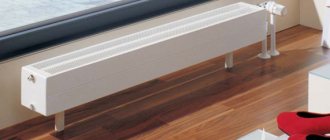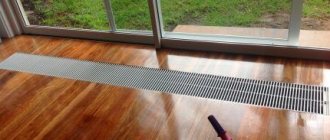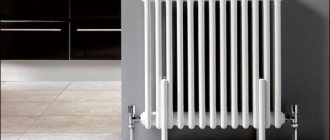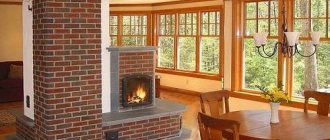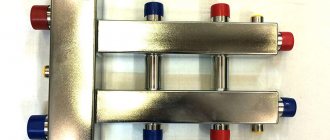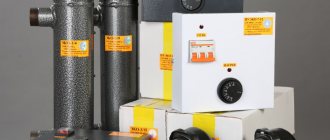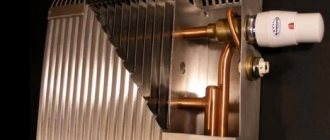Here you will learn:
- Principle and design of water convectors
- Types of water convectors
- Features of choice
- Installation of water convectors
Heating systems with classic radiators can heat a room in two ways - using convection and thermal radiation. If we talk about water heating convectors, they heat only due to natural convection, ensuring the circulation of warm air masses in the rooms. Fast and efficient heating of rooms is achieved. What are water convectors and how do they work? Let's talk about this as part of our review.
We will also look at:
- principles of operation of water convectors;
- types of devices;
- characteristics and properties of this heating equipment;
- installation principles.
After reading the material, you will receive all the necessary knowledge about these devices.
Principle of operation
The very word “convector” indicates that the principle of its operation is based on such a physical phenomenon as convection. Cold air, being more dense, is located in the lower layers - near the floor of the room. Having passed through the convector, the air warms up, its density decreases, as a result of which it rises.
Convection can be not only natural, but also forced. The built-in fan will help increase the convection air flow and thereby increase the efficiency of the heating device.
Kinds
There are electric built-in convectors and water heating devices. If we consider these units based on the principle of operation and design features, then here we can also distinguish several separate varieties.
Devices with natural convection or natural circulation of air masses. The operation of such devices is to heat the heat exchanger and gradually naturally move warm air masses to the upper zones of the room. Heated air currents mix with cold air, which leads to slow heating of the entire room.
Fan coil units can be built into the floor, wall-mounted or floor-mounted. Such devices represent the joint work of two devices at once. The first of them is the fan coil itself - a special mechanism that affects the temperature and has from one to several heat exchangers. The second is a chiller. This device is installed separately and serves directly to cool the air masses entering the fan coil unit.
In terms of their design, such units can be either single-circuit, that is, two-pipe (some call them single-pipe), or double-circuit (or four-pipe). Devices of the first type pass water from central heating heated through a heat exchanger in winter. In the summer, already cooled water from the chiller is passed through the same heat exchanger.
Dual-circuit devices assume that hot and cold water enters different heat exchangers in certain seasons. These devices usually provide several heating modes, where, depending on the one selected, cold or warm air flows enter the room.
A clear advantage of fan coil units is their versatility, as well as the ability to be installed in any room. The disadvantage of such units is their high cost and relative difficulty of maintenance, which is why they can rarely be found in apartments and private houses.
Water heating convector device
The main working element of the convector is the heat exchanger. It is with its help that heat is transferred from the coolant, the function of which is performed by hot water circulating in the heating system, to the surrounding air. The heat exchanger is a pipe on which many metal plates (lamellas) are mounted, increasing the heat exchange area. Depending on the required power, the convector can be equipped with either one or two heat exchangers.
The distance between the lamellas of the heat exchanger is not set arbitrarily, but is clearly calculated. It would seem that the more plates are mounted on the pipe, the better the heat transfer. However, if their density is too high, air circulation through the device will be difficult. It is necessary to achieve the “golden mean” - so that the lamellas do not interfere with air movement, but at the same time ensure the most efficient heat transfer.
1. Convector housing. 2. Heat exchanger. 3. Decorative lattice. 4. Tangential fan. 5. Large decorative cover.
6. Small decorative cover. 7. Decorative edging. 8. Mounting leg. 9. Adjustment screws. 10. Mounting bolt.
11. Ball valve. 12. Shut-off and control valve. 13. Flexible eyeliner. 14. Gaskets.
There is also an alternative type of heat exchanger from a design point of view, in which wire is used instead of lamellas. Wire convectors are somewhat more efficient, but at the same time much more expensive, and therefore less common than plate convectors, so we will not talk about them in more detail.
Water convector with wire heat exchanger.
Many technical characteristics of the convector are determined by the material from which its heat exchanger is made. It can be steel, copper or a combination of copper and aluminum. The use of non-ferrous metals for the manufacture of a heat exchanger, due to their high thermal conductivity, leads to an increase in the efficiency of the device in comparison with its analogue made of ferrous metal. By the way, aluminum lamellas are very thin, and if handled carelessly they easily become jammed, which impairs aerodynamics.
Heat exchangers can differ not only in the material of manufacture, but also in the shape of the metal fins. Along with smooth lamellas, corrugated ones are also used: wavy, U-shaped, meander, etc. Corrugated lamellas have a clear advantage: the relief increases the area of the plate, and therefore heat transfer.
Heat exchanger with wave-shaped lamellas.
The efficiency of heat transfer from the coolant to the lamellas largely depends on the tightness of the plates to the pipe: even a small gap can cause large heat losses. If the heat exchanger is made of steel, welding is usually used to connect the lamellas to the pipe; if it is made of copper, soldering is used.
In the case of bimetallic heat exchangers, in which aluminum plates are in contact with copper pipes, neither welding nor soldering is applicable. However, even here it is possible to achieve a tight fit of the elements. In this case, either lamellas with special cuffs are used, or the mandrel method is used - plates are placed on a pipe, and then this pipe is expanded using a mandrel.
Some convectors are equipped with a fan that draws air into the heat exchanger and, thereby, speeds up air exchange, and therefore the process of heating the room. The fan can be tangential or axial. The first has an impeller that extends along the entire length of the heat exchanger.
The axial fan propeller is located at the end of the heat exchanger and directs air along it.
The advantage of a heating device with forced convection is obvious - increased efficiency. But it also has obvious disadvantages: firstly, the need to connect to the mains, which may not always be easy to implement, and secondly, the noise that the fan makes during operation.
The heat exchanger, as well as the fan (if provided for by the design), connection points to the heating system, coolant supply regulator, and air release valve are hidden behind the walls of the stainless steel housing. The upper end of the case is covered with a grille, which does not interfere with the movement of air flows, but at the same time prevents foreign objects from getting inside. Some convectors have an air damper that allows you to control the intensity of air flow.
Features of choice
When choosing water convectors, you must pay attention to several important indicators:
- Control method: manual and remote. In the case of a device that needs to be controlled manually, you will need to constantly turn the device on and off; the remote method allows you to carry out these manipulations at a distance.
- Power. The rate of heating of the room will depend on this indicator. The higher the power, the faster the air in the rooms will heat up.
- The presence of a thermostat. This element is not present in all devices, but it is very useful because... it monitors the temperature and can itself determine when the device should be turned on and off. In other words, thanks to the thermostat, your unit will be protected from overheating.
- A heating element. This indicator is also very important. Its main characteristic is the area that is in contact with the environment. The larger it is, the higher the performance of the convector.
- Frame. If you want the device not to spoil your interior, but rather to fit harmoniously into it, pay attention to the appearance and material from which the heater body is made. Steel models are the most widely used because... are characterized by high strength.
There are also in-floor and baseboard electric convectors.
Wall and floor water heating convectors
According to the installation method, all heating convectors are divided into wall-mounted, floor-mounted and in-floor. The first two types are very similar to each other, so we will consider them together.
The main difference between wall and floor convectors, which are very similar in appearance, is their dimensions. Wall-mounted ones are usually quite high, while floor-mounted ones are low and compact. The latter, due to their modest size, are less conspicuous and can be easily hidden behind furniture.
Wall-mounted water convector.
Floor water convector.
There are even baseboard models with a height of less than 200 mm, which can serve as a replacement for baseboards and heat the room along the entire perimeter.
Skirting water convector.
All wall and floor convectors are divided into models with a casing and models without it. The casing does not perform a decorative role, as one might expect: it helps create additional traction to improve air circulation. Often the height of the casing significantly exceeds the dimensions of the heat exchanger. This discrepancy is not at all a defect of the manufacturer; it is done intentionally: the higher the casing, the stronger the thrust. As for convectors without a casing, they also have a casing, but it only masks the heat exchanger and protects it from mechanical damage.
It should be noted that the surface of the functional casing or decorative housing does not heat up too much. This distinguishes convectors from radiators - in this case you cannot get burned by accidentally touching the surface of the housing.
Most often, convector bodies are made of steel, regardless of the heat exchanger material. The fact is that steel is easy to paint, and this gives the buyer the opportunity to choose a heating device that will fit perfectly into the interior of the room. However, steel, although the most common, is not the only option. If you wish, you can find something more exotic, for example, a convector in a wooden case.
Kinds
There are electric built-in convectors and water heating devices. If we consider these units based on the principle of operation and design features, then here we can also distinguish several separate varieties.
Devices with natural convection or natural circulation of air masses. The operation of such devices is to heat the heat exchanger and gradually naturally move warm air masses to the upper zones of the room. Heated air currents mix with cold air, which leads to slow heating of the entire room.
Fan coil units can be built into the floor, wall-mounted or floor-mounted. Such devices represent the joint work of two devices at once. The first of them is the fan coil itself - a special mechanism that affects the temperature and has from one to several heat exchangers. The second is a chiller. This device is installed separately and serves directly to cool the air masses entering the fan coil unit.
In terms of their design, such units can be either single-circuit, that is, two-pipe (some call them single-pipe), or double-circuit (or four-pipe). Devices of the first type pass water from central heating heated through a heat exchanger in winter. In the summer, already cooled water from the chiller is passed through the same heat exchanger.
Dual-circuit devices assume that hot and cold water enters different heat exchangers in certain seasons. These devices usually provide several heating modes, where, depending on the one selected, cold or warm air flows enter the room.
A clear advantage of fan coil units is their versatility, as well as the ability to be installed in any room. The disadvantage of such units is their high cost and relative difficulty of maintenance, which is why they can rarely be found in apartments and private houses.
Water heating convectors built into the floor
There is another type of heating convectors, which is very different from those discussed above and therefore stands apart. They are unusual in the location of their installation - in a niche located below floor level. With a high degree of probability, you can find such heating devices in commercial or office premises with large panoramic windows, against which ordinary radiators or convectors will not look entirely appropriate.
In cottages and apartments, such convectors are also installed, but usually only in cases where the lower edge of the window is located no higher than 150-300 mm from the floor level. It is allowed to install heating convectors into the window sill.
Water heating convector built into the floor.
The height of the body of convectors built into the floor can vary from 50 to 130 mm, and the length can reach 3 m. But the user, unless he himself has been involved in design and installation, can only guess about the true dimensions of the heating device, because he will only be able to see the decorative grille at the level floor through which heated air rises upward.
Most often, such gratings are made of steel, aluminum or plastic, but sometimes you can find cast iron, marble or, for example, wood. Whatever material the grille is made of, it must be strong enough so that you are not afraid to step on it when passing by.
In the case of large French windows, in-floor convectors are an indispensable option for heating equipment. On the one hand, and we have already mentioned this, they, being located below floor level, do not interfere with the view. On the other hand, it is precisely such convectors that most effectively heat a room with floor-to-ceiling windows. Cold air from the window enters the convector through the grille, and from there it comes out the same way as warm air.
To install an in-floor convector, it is necessary to prepare in advance a niche in the floor with a depth of 100 to 300 mm. However, installation can also be carried out at the stage of floor screeding. It should be borne in mind that not every convector can be used for in-floor installation.
The limiting factor in this case will be the height of the device body. Powerful models with a height of several tens of centimeters are not intended for installation in rooms located on the upper floors of a building. Of course, the installation of in-floor convectors should be planned in advance - even at the stage of building construction. The exception is low-power, low-rise models that allow installation in a screed.
In-floor water heating convectors, unlike wall-mounted or floor-mounted ones, often have a fan in their design for forced air supply to the heat exchanger, as well as a drainage system for collecting and removing condensate from the device body.
Which to choose?
The key criteria when choosing floor-mounted convectors will be two important points - power and interior design features of the heated room. The first indicator can be found in the description of any model of the equipment in question and in the corresponding technical documentation included in the delivery package. This takes into account the characteristics of the room and potential heat loss.
Taking into account all the existing nuances, when deciding on the choice of a particular in-floor heater, the following factors must be taken into account:
- the power of the system is calculated taking into account possible heat losses in each room;
- the dimensions of the convector must be comparable to the dimensions of the niche in the floor in which it will be installed;
- each purchased unit of heating equipment must comply with current GOSTs and be certified;
- it is necessary to ensure that the pressure testing pressure of the convector corresponds to the corresponding indicators of the entire system;
- Taking into account the characteristics of the room, choose devices with a fan or with natural circulation of air flows.
Heaters of this type are most relevant in situations where the creation of an effective thermal curtain is required. Often such systems are installed in children's institutions. This is due to their maximum safety and the absence of risks of burns.
Possibility of temperature control
Sometimes, especially in the spring, when it is still cold at night, and the sun is already beginning to noticeably warm up during the day, you periodically have a desire to reduce the heat coming from the heating device. Water heating convectors are easy to adjust their power. When the coolant supply to the convector is shut off, it will cool down quite quickly, which is due to the small volume of water inside it compared to the radiator.
All you need to maintain the room temperature at a given level is to equip the convector with thermostatic fittings with mechanical or electronic control.
Mechanical thermostatic valves.
Electronic thermostatic valves.
The installed thermostatic valve must have high flow capacity so that significant hydraulic resistance does not create at the inlet. Some convector manufacturers initially equip their products with thermostatic fittings. If the device you purchased is not equipped with a thermostatic valve, you can purchase and install it yourself.
You can also regulate the air temperature in the room manually. Some models of convectors have a damper, which the user can, if desired, turn and thereby block the path of heated air.
Basement
Another relatively recent development is base-mounted water convectors. Such devices are similar to the previous type in that they are also installed hidden - the principles and possible installation points are absolutely identical. Thanks to plinth convectors, you can install very reliable and completely invisible heating in any room.
Any basement heating convector requires a connection to the electrical network. Electricity is used to operate fans that provide forced convection. The design of base convectors uses low-noise fans, so you don’t have to think about eliminating unnecessary noise.
Can be used for room cooling
A convector can be called universal climate control equipment, since it can perform different tasks in different seasons: heating in winter, cooling in summer. True, not every device is adapted for cooling; manufacturers usually indicate that one or another of their models has this capability.
It should be borne in mind that convectors generate cold much worse than heat, so when calculating the power of the device, you need to rely on your needs for cold, because reducing the heating power, as you now know, is not difficult.
In order for your convector to start cooling, rather than heating, the air in the room, you need to empty it, fill it with a special liquid and connect it to the chiller. However, there are models in which the process of transition from one mode to another is much simpler and faster. They have two unconnected circuits at once: one for the coolant, the other for the refrigerant. To change the operating mode, you will only need to turn off the fluid circulation in one circuit and turn it on in the other.
And a couple more comments regarding the possibility of using this type of climate control equipment for cooling a room. Remembering the principle of operation of a convector, you will understand that in natural mode it is not able to work for cooling. That is why all models designed to operate in two modes are equipped with fans. In addition, the fan helps reduce the amount of condensate formed on the heat exchanger when the convector is operating for cooling.
Differences between radiator and electric types
In electric and water in-floor heating devices, fans are installed to increase power. This allows you to get much more heat from convectors.
The fans operate on 12, 24 V DC and 220 V AC. To reduce the noise level, they are placed on vibration-proof supports.
Despite the noise that usually comes from forced convection convectors, they have important advantages. The devices produce more heat and precipitate cold currents that come from the glass surface
If the owner of the premises plans to use a water in-floor convector as the only or main source of heat, it is recommended to choose models with forced convection. They quickly and efficiently heat the air in the room, preventing condensation from settling on the glass.
Some models, for example, products from Kermi, can be used not only for heating rooms, but also for cooling them. This happens thanks to the use of 2 separate heat exchange elements connected to different systems - heating and cooling.
There are 2 types of built-in systems - two-pipe and four-pipe. In two-pipe systems, 1 heat exchanger works with 2 systems.
On the modern market there are modifications of in-floor convectors that supply clean and warm air to the room. First, it enters a special hole, then it is cleaned using built-in filters. Then the air is heated, after which it enters the room.
Water in-floor convectors with built-in filters are optimally suited for installation in rooms with double-glazed windows. They usually have low humidity and lack of oxygen.
Manufacturers also produce in-floor devices for effective heating of residential, commercial and industrial premises with high humidity levels. In their production, moisture-resistant and modern electrical equipment is used. These models are equipped with a drain to remove accumulated condensate.
Before starting repairs, you can order a convector of a non-standard size, corresponding to the characteristics of the room.
Some manufacturers make rotating heating elements that make cleaning the inside of the case easier. The heat exchanger can be installed on flexible hoses, making it easy to remove for cleaning.
At the client's request, convectors built into the floor are made with the required radius of curvature or angular. This is more often used for decorating shop windows or rooms with non-standard geometry.
Electronic or electromechanical thermostats are responsible for controlling the temperature and power of the convector. They are located in the device body and are controlled using a remote or remote control. Electronic thermostats allow you to program the temperature by time of day and day of the week.
